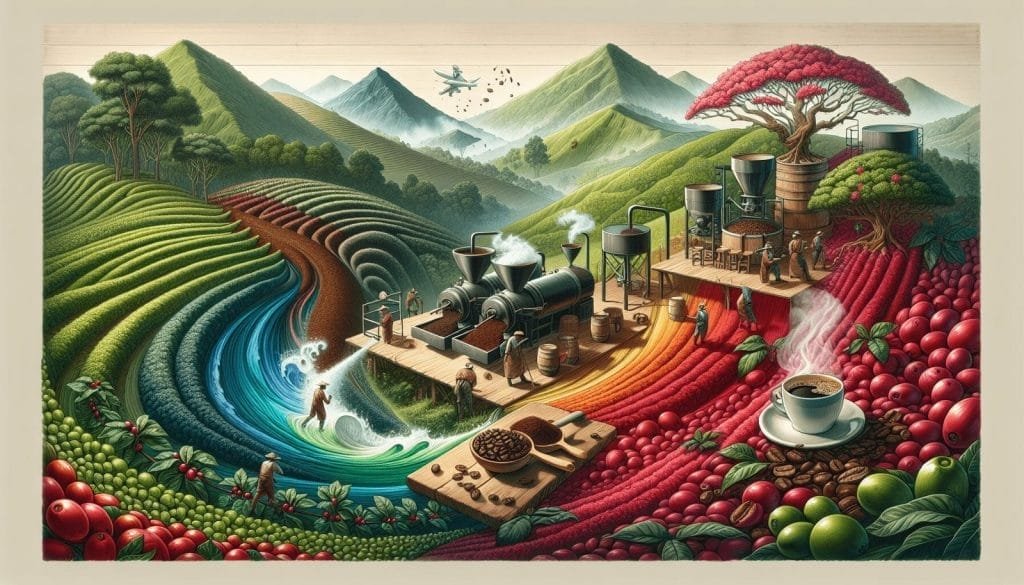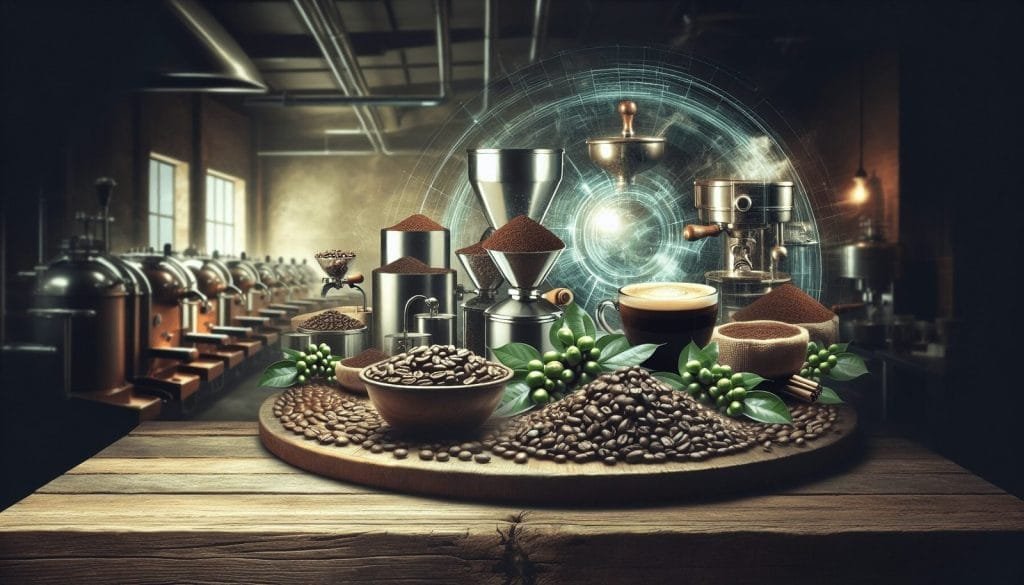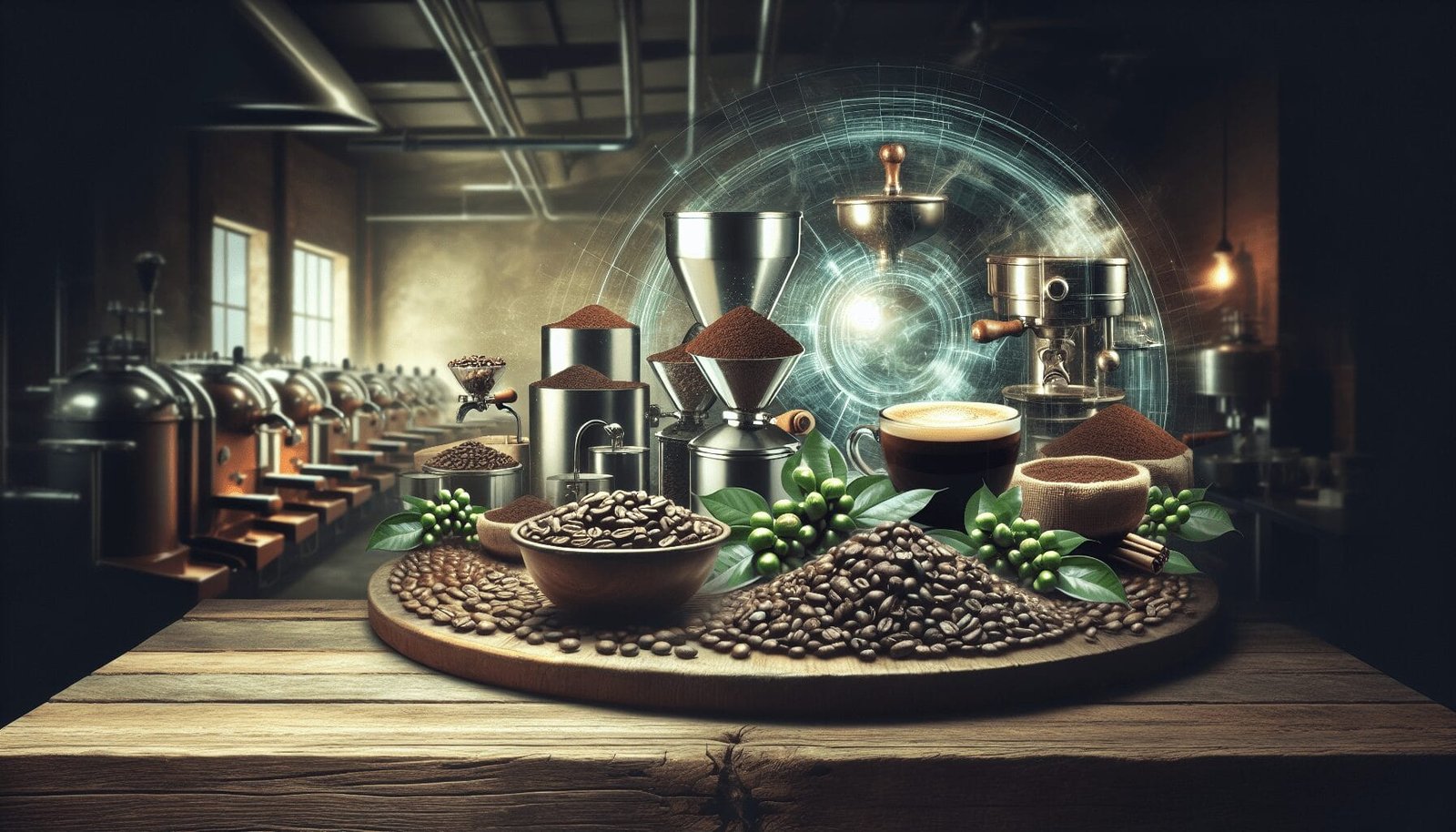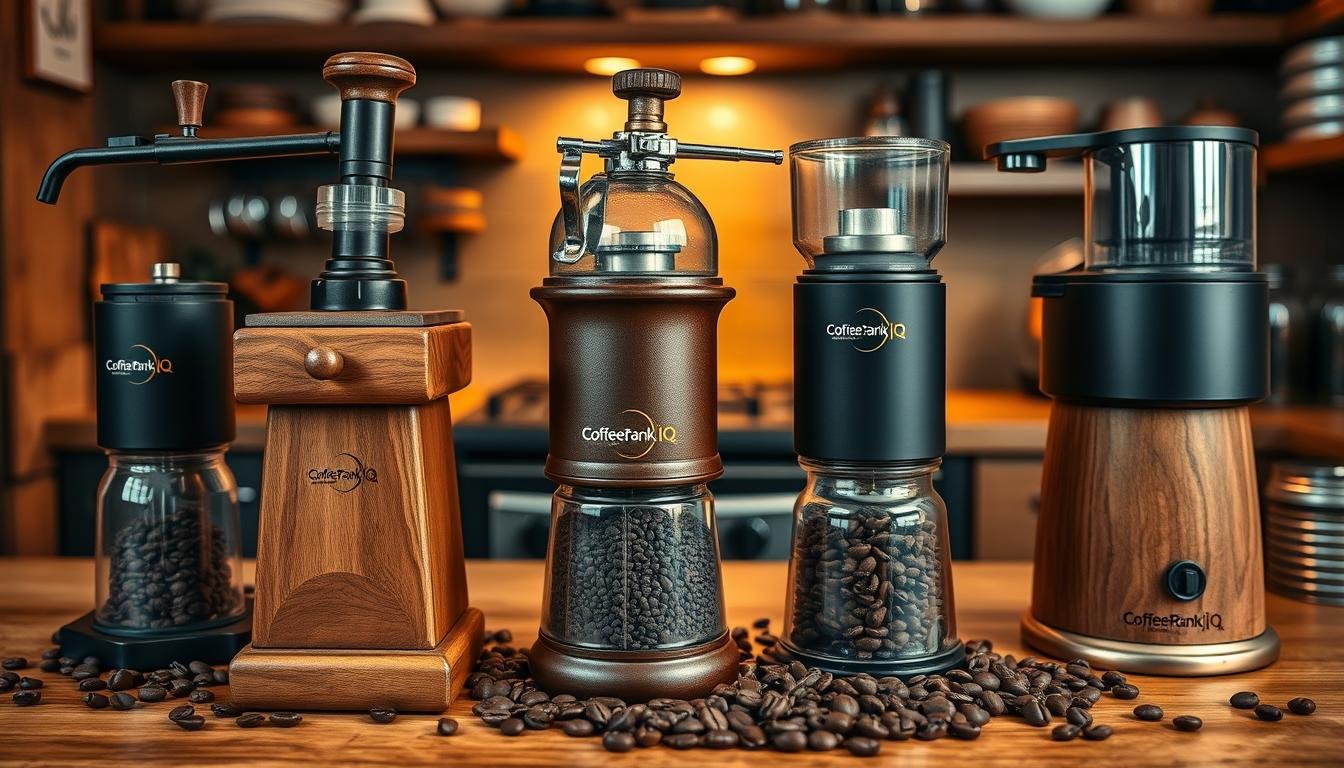Picture yourself walking into a bustling Starbucks, the warm aroma of freshly brewed coffee filling the air. As you step up to the counter, you can’t help but wonder – what coffee bean does Starbucks use to create their beloved beverages? This burning curiosity is shared by countless coffee enthusiasts, and in this article, we will finally unveil the secret behind the beans that fuel the Starbucks empire. Prepare to be captivated as we uncover the origins and characteristics of the coffee bean that has become synonymous with Starbucks’ distinct flavor. Get ready to embark on a journey through the world of coffee, where passion, artistry, and a touch of creativity combine to create the perfect cup.

Starbucks Coffee Beans
Welcome to the world of Starbucks coffee beans! In this comprehensive article, we will delve into the intriguing origin of Starbucks coffee, the different types of coffee beans they use, their iconic coffee blends, and their ethical sourcing practices. Get ready to embark on a delicious and enlightening journey!
Starbucks Coffee Origin
To truly appreciate the Starbucks coffee experience, it is essential to understand its origin. Starbucks sources its coffee beans from various regions around the world, each with its own unique characteristics and flavors. From the lush coffee plantations of Latin America to the vast landscapes of Africa and the vibrant coffee-growing regions of the Asia-Pacific, Starbucks carefully selects beans that meet their high standards of quality.
Starbucks Coffee Bean Types
Starbucks believes in the art of blending the perfect cup of coffee, and this starts with the choice of coffee beans. The two primary types of coffee beans they use are Arabica and Robusta. Arabica beans, known for their nuanced flavors, account for the majority of Starbucks’ coffee offerings. On the other hand, Robusta beans, with their higher caffeine content and stronger taste, add depth and intensity to certain blends.
Starbucks Coffee Bean Blends
One of the many reasons why Starbucks stands out in the world of coffee is its exceptional coffee blends. Let’s explore some of their well-loved blends:
House Blend
The House Blend is the quintessential Starbucks brew. It is a medium-roasted blend that strikes a perfect balance between vibrant acidity and rich flavors. With notes of nuts and cocoa, this blend is a crowd-pleaser for any coffee enthusiast.
Sumatra
For those seeking a bold and earthy experience, Sumatra is the answer. Grown on Indonesian islands, this dark-roasted blend captures the essence of the region’s volcanic soils. Its full-bodied flavor and distinct herbal notes make it an irresistible choice for coffee connoisseurs.
Pike Place Roast
Inspired by Starbucks’ first store in Seattle’s Pike Place Market, this medium-roasted blend boasts a smooth and well-rounded taste. Pike Place Roast is characterized by its layers of cocoa and toasted nuts, making it a reliable go-to for a daily cup of comfort.
Veranda Blend
If you prefer a milder and more delicate coffee, the Veranda Blend is the ideal choice. This blonde-roasted blend features light-bodied flavors of soft cocoa and toasted nuts, perfect for those who enjoy a smoother and less intense coffee experience.
Blonde Roast
Starbucks’ Blonde Roast embraces the lighter side of coffee, catering to those who prefer a brighter and more subtle flavor profile. Delighting the taste buds with hints of lemon and toasted nuts, this blend offers a refreshing twist to the classic coffee experience.
Dark Roast
For the bold at heart, Starbucks’ Dark Roast blend is a true delight. Exhibiting a robust and smoky flavor, this blend is carefully roasted to bring out deep caramelized sweetness and notes of rich chocolate. It’s a bold choice for those who crave a powerful and intense coffee experience.
Single-Origin Coffees
Starbucks also offers a range of single-origin coffees, allowing customers to explore the unique flavors and aromas of specific coffee-growing regions. From the vibrant and fruit-forward Ethiopian Yirgacheffe to the smooth and spicy flavors of Guatemala Antigua, these single-origin coffees provide an opportunity to take a sip and travel the world from the comfort of your own home.

Starbucks Coffee Sourcing Practices
Starbucks takes pride in its commitment to ethical sourcing practices, ensuring that coffee farmers and their communities receive fair treatment and support. Here are some of the practices they employ:
C.A.F.E. Practices
Starbucks developed its Coffee and Farmer Equity (C.A.F.E.) Practices program to promote sustainable coffee farming practices. This initiative encompasses social, economic, and environmental standards, encouraging coffee farmers to adopt responsible and ethical practices that prioritize the well-being of both the land and the people.
Fairtrade Certified Coffee
In addition to their C.A.F.E. Practices, Starbucks also supports fair trade by offering Fairtrade certified coffee. This certification ensures that farmers receive fair prices for their coffee and are able to invest in their communities, creating a positive impact on their lives and livelihoods.
Support for Coffee Communities
Starbucks recognizes the importance of investing in the communities that produce their coffee. Through various initiatives, such as the Starbucks Farmer Support Centers, the company provides resources, training, and support to coffee farmers, empowering them to enhance their farming techniques and improve the quality of their coffee.
Coffee Quality and Taste
At Starbucks, the pursuit of excellence in coffee quality and taste is a top priority. By establishing strong relationships with coffee farmers and utilizing sustainable farming practices, Starbucks ensures that only the finest beans are selected for their blends. This dedication to quality and taste is what sets Starbucks apart and contributes to the exceptional coffee experience enjoyed by millions worldwide.
Regions Starbucks Sources From
Starbucks sources its coffee beans from a diverse range of regions, each offering distinct flavors and characteristics. Let’s explore the coffee-growing regions that contribute to Starbucks’ exceptional blends:
Latin America
Latin America is renowned for producing high-quality Arabica beans, known for their nuanced flavors and balanced acidity. Countries like Colombia, Costa Rica, and Brazil are key coffee-growing regions in this area. Each region within Latin America brings its own unique twist to the world of coffee, offering flavors that range from fruity and bright to chocolatey and nutty.
Africa
African coffee is celebrated for its complexity and vibrancy. Specialty coffees from Ethiopia, Kenya, and Tanzania showcase distinctive flavors that are often considered exotic and captivating. With floral, fruity, and wine-like notes, African coffee provides an exciting taste adventure for coffee enthusiasts.
Asia-Pacific
The Asia-Pacific region offers a diverse array of coffee profiles. Countries such as Indonesia, Vietnam, and Papua New Guinea contribute to the region’s coffee production. Asian coffees are known for their earthy tones, spice accents, and full-bodied flavors that cater to those seeking a bolder and more robust coffee experience.
Mixed Region Blends
Beyond single-origin coffees, Starbucks also expertly combines beans from different regions to create enticing mixed blends. These blends bring together the finest beans from various regions, allowing coffee lovers to indulge in a harmonious fusion of flavors and aromas.
Ethical Sourcing Practices
Starbucks is committed to ethical sourcing practices that prioritize the well-being of coffee farmers and their communities. Here are some of the ways in which they strive to make a positive impact:
Farmer Support Centers
Starbucks established Farmer Support Centers in coffee-growing regions worldwide. These centers provide valuable resources and knowledge to farmers, empowering them to improve their farming techniques, increase productivity, and ensure the long-term sustainability of their coffee crops.
Farmer Loans and Investments
Recognizing the financial challenges faced by coffee farmers, Starbucks offers farmer loans and investments. This support enables farmers to access the capital they need to invest in their businesses, improve their infrastructure, and ultimately enhance the quality of their coffee.
Training and Education Programs
Starbucks understands the importance of knowledge sharing and capacity building. Through training and education programs, they equip coffee farmers with the skills needed to maintain sustainable and environmentally friendly farming practices. These initiatives not only ensure the quality of the coffee but also contribute to the overall well-being of the communities involved.
Relationships with Coffee Farmers
Establishing strong and mutually beneficial relationships with coffee farmers is a cornerstone of Starbucks’ approach to sourcing coffee. Here are some of the ways in which they foster these relationships:
Coffee and Farmer Equity (C.A.F.E.) Practices
Starbucks’ Coffee and Farmer Equity (C.A.F.E.) Practices go beyond certifications and regulations. It is a comprehensive program that focuses on building direct relationships with coffee farmers, promoting transparency, and supporting long-term sustainability. This approach allows Starbucks to work closely with farmers to ensure the highest quality beans while prioritizing environmental and social responsibility.
Direct Trade
Starbucks believes in cutting out the middlemen and fostering direct relationships with coffee farmers whenever possible. By eliminating unnecessary intermediaries, Starbucks can ensure that farmers receive fair prices for their crops and establish a deeper connection with the individuals who grow the coffee beans that we enjoy.
Supplier Diversity
Starbucks understands the importance of supporting coffee farmers from diverse backgrounds. By partnering with a wide range of suppliers, Starbucks not only promotes inclusivity but also celebrates the unique flavors and characteristics that different regions and communities bring to their coffee offerings.
Arabica Coffee Beans
Arabica coffee beans are considered the backbone of Starbucks’ coffee selection. Renowned for their complex flavors and delicate nuances, these beans provide the foundation for many of Starbucks’ blends. Let’s dive deeper into the world of Arabica coffee:
Flavor Profile
Arabica beans offer a wide range of flavor profiles, from fruity and bright to chocolatey and nutty. They are often celebrated for their balanced acidity, refined sweetness, and subtle undertones. With each region contributing its own unique flavors, Arabica coffee provides a captivating and dynamic taste experience.
Preferred Growing Conditions
Arabica coffee thrives in moderate climates with altitudes ranging from 2,000 to 6,000 feet. They prefer cooler temperatures and ample rainfall, allowing the beans to develop slowly and achieve optimal flavor. The unique combination of altitude, rainfall, and soil composition in each region contributes to the distinct flavor characteristics of Arabica beans.
Common Varieties
Some of the common Arabica varieties found in Starbucks’ blends include Colombian, Costa Rican, Guatemalan, and Ethiopian beans. Each variety brings its own distinct flavors, allowing Starbucks to create a diverse range of coffee blends that cater to various taste preferences.
Robusta Coffee Beans
While Arabica beans occupy center stage in Starbucks’ coffee lineup, Robusta beans play an essential supporting role in certain blends. Let’s explore the characteristics of Robusta beans:
Flavor Profile
Robusta beans possess a bolder and more intense flavor compared to Arabica beans. With higher caffeine content and a stronger taste, they bring depth and richness to certain blends, adding a delightful kick to the overall coffee experience. The flavors of Robusta beans often include a hint of bitterness, coupled with notes of chocolate and earthiness.
Preferred Growing Conditions
Robusta coffee plants are robust and adaptable, thriving in lower altitudes and warmer temperatures. They are resilient against pests and diseases, making them easier to cultivate. Regions such as Vietnam, Brazil, and Uganda are known for their Robusta coffee production, providing a steady supply for Starbucks’ blends that crave a more intense flavor profile.
Common Varieties
The most common variety of Robusta coffee used in Starbucks’ blends is the Coffea canephora variety. With its high caffeine content and distinct flavor characteristics, this variety delivers a kick of intensity and robustness to the blends in which it is featured.
In conclusion, Starbucks Coffee Beans offer a diverse and exciting world of flavors and aromas. From the origins of their beans to the meticulous blending process and their commitment to ethical sourcing, Starbucks is dedicated to delivering exceptional coffee experiences. Whether you prefer the smooth and well-rounded taste of their House Blend or the bold and exotic flavors of their single-origin coffees, Starbucks has something for every coffee lover. So, get ready to savor the richness and complexity that Starbucks Coffee Beans bring to your cup, one delicious sip at a time.




